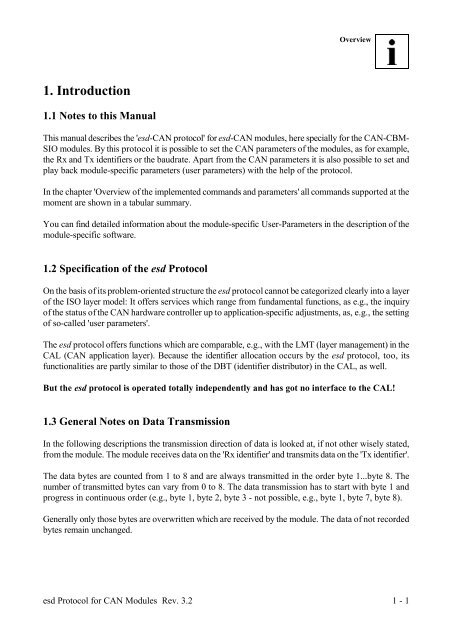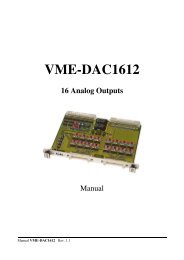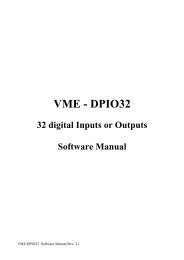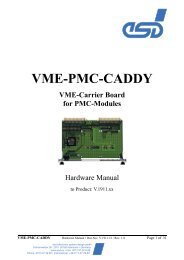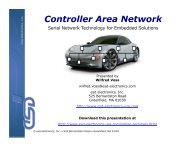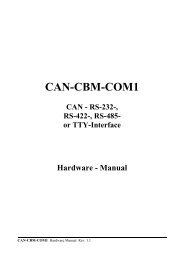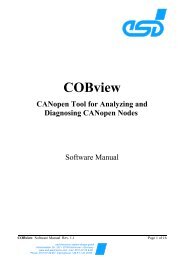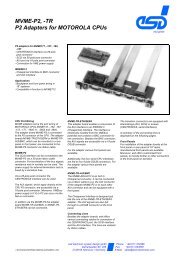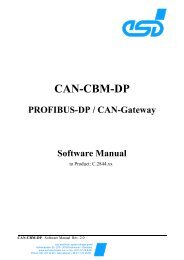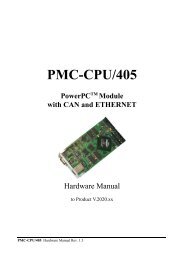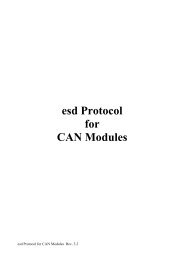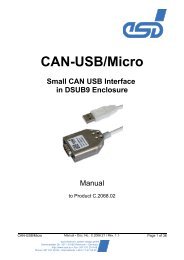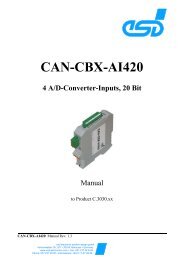Download CAN protocol manual (PDF-File) - esd electronics, Inc.
Download CAN protocol manual (PDF-File) - esd electronics, Inc.
Download CAN protocol manual (PDF-File) - esd electronics, Inc.
Create successful ePaper yourself
Turn your PDF publications into a flip-book with our unique Google optimized e-Paper software.
1. Introduction<br />
1.1 Notes to this Manual<br />
Overview<br />
This <strong>manual</strong> describes the '<strong>esd</strong>-<strong>CAN</strong> <strong>protocol</strong>' for <strong>esd</strong>-<strong>CAN</strong> modules, here specially for the <strong>CAN</strong>-CBM-<br />
SIO modules. By this <strong>protocol</strong> it is possible to set the <strong>CAN</strong> parameters of the modules, as for example,<br />
the Rx and Tx identifiers or the baudrate. Apart from the <strong>CAN</strong> parameters it is also possible to set and<br />
play back module-specific parameters (user parameters) with the help of the <strong>protocol</strong>.<br />
In the chapter 'Overview of the implemented commands and parameters' all commands supported at the<br />
moment are shown in a tabular summary.<br />
You can find detailed information about the module-specific User-Parameters in the description of the<br />
module-specific software.<br />
1.2 Specification of the <strong>esd</strong> Protocol<br />
On the basis of its problem-oriented structure the <strong>esd</strong> <strong>protocol</strong> cannot be categorized clearly into a layer<br />
of the ISO layer model: It offers services which range from fundamental functions, as e.g., the inquiry<br />
of the status of the <strong>CAN</strong> hardware controller up to application-specific adjustments, as, e.g., the setting<br />
of so-called 'user parameters'.<br />
The <strong>esd</strong> <strong>protocol</strong> offers functions which are comparable, e.g., with the LMT (layer management) in the<br />
CAL (<strong>CAN</strong> application layer). Because the identifier allocation occurs by the <strong>esd</strong> <strong>protocol</strong>, too, its<br />
functionalities are partly similar to those of the DBT (identifier distributor) in the CAL, as well.<br />
But the <strong>esd</strong> <strong>protocol</strong> is operated totally independently and has got no interface to the CAL!<br />
1.3 General Notes on Data Transmission<br />
In the following descriptions the transmission direction of data is looked at, if not other wisely stated,<br />
from the module. The module receives data on the 'Rx identifier' and transmits data on the 'Tx identifier'.<br />
The data bytes are counted from 1 to 8 and are always transmitted in the order byte 1...byte 8. The<br />
number of transmitted bytes can vary from 0 to 8. The data transmission has to start with byte 1 and<br />
progress in continuous order (e.g., byte 1, byte 2, byte 3 - not possible, e.g., byte 1, byte 7, byte 8).<br />
Generally only those bytes are overwritten which are received by the module. The data of not recorded<br />
bytes remain unchanged.<br />
<strong>esd</strong> Protocol for <strong>CAN</strong> Modules Rev. 3.2 1 - 1


